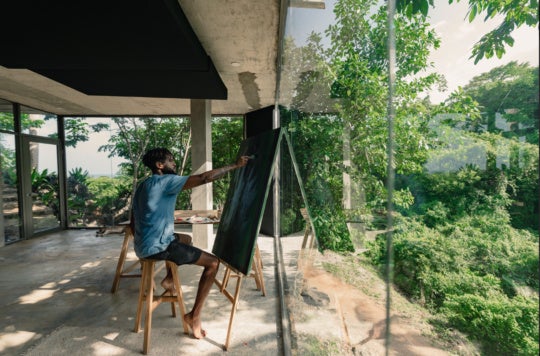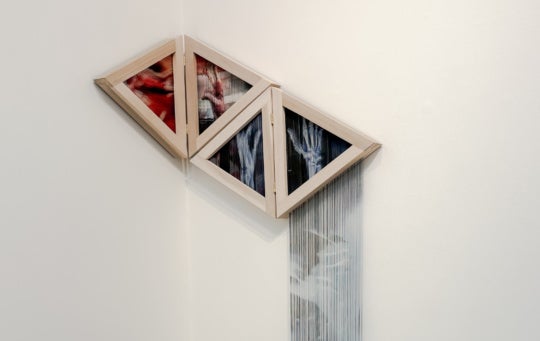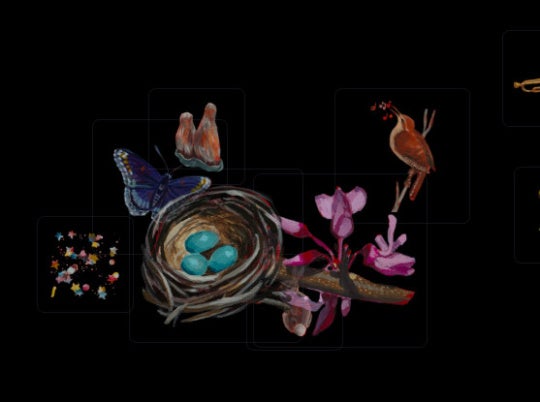
From the moment a frequent visitor to the Institute of Contemporary Art in Boston enters “Leap Before You Look: Black Mountain College 1933-1957,” it is evident that this exhibition is different from the ICA’s usual fare. It is larger, containing over 200 works on loan from numerous institutions, and it is historical, telling the story of the hugely influential, though small, Black Mountain College near Asheville, North Carolina. Curated by the ICA’s former chief curator, Helen Molesworth, who is now the chief curator at the Museum of Contemporary Art, Los Angeles, with ICA assistant curator Ruth Erickson, “Leap Before You Look” is ambitious, comprehensive, and engages the ICA’s entire building. It encompasses one of the most compelling examples of how education and community can positively influence art-making, with works of visual art, music, and dance, providing evidence of how time spent there enriched artists’ output.
An antechamber to the exhibition functions as a timeline, dominated by words and dates written in black vintage typeface that sets the mood for a visit to the past, specifically to 1933, when Anni and Josef Albers arrived on campus shortly after the school’s founding. The first gallery of the exhibition is devoted to the Albers, which establishes Black Mountain’s role as a multidisciplinary setting for learning, with courses in painting, printmaking, weaving, and furniture design. The Albers’ works alone provide examples of multiple mediums executed by faculty with the highest level of technical and aesthetic ability.

Particularly impressive are cotton and linen wall hangings by Anni Albers. The weaving program at Black Mountain was part of a continuation of the designer-craftsman model used at the Bauhaus, where she had studied and then taught before fleeing Germany. Weaving was taught for its own merit, but also for how the lessons could inform industrial and machine design. I was also captivated by a wooden desk designed by Josef Albers, placed beneath one of his geometric abstractions that precisely realizes his color theory. The show demonstrates the Albers’ immense gifts in various disciplines, putting into practice the Bauhaus tenet that philosophy and art-making could transcend boundaries between mediums.

The exhibition encompasses a range of styles and levels of fame. It boasts examples from the canon of 20th-century art, including works by Willem de Kooning (Asheville, 1948), Franz Kline (Painting, 1952), and Robert Rauschenberg (several works, including Minutiae, 1954/1976). Past the spaces devoted to the Albers are examples that read as exercises or studies rather than completed works. Among these are real leaves on paper, including a particularly engaging example accompanied by a loop of tinsel-slim silver by Ruth Kasawa, jewelry made with simple, rhythmically repeating, inexpensive materials, including cork, Bobby pins, and hardware, and a grid of samples made for color theory lessons.

Instrumental music, at times harmonious and at other times less so, plays throughout the galleries and serves as the Soundscape component of the exhibition (organized by John Andress, associate director of performing arts at the ICA). Music provides an immediacy that can transcend time, providing an effective way to animate history. Worn furniture, including stools and benches, also prompted a sense that the exhibition takes you beyond art viewing in favor of a dreamy campus tour. Even Josef Albers’s desk has the patina of use, but its square, streamlined shapes give away its grand origins. The used condition of the examples on display may have been for practical purposes, as pristine examples may not exist, but the bumps and scratches awakened the possibility that one of your favorite artists may have sat there. The worn furniture refers directly to the classroom and to the creative process, offering for viewers a specific setting and state of mind. .

The performances and activities for this exhibition, ranging from theater to music to art-making, are so numerous and frequent that it would be difficult for a visitor to miss one. While I was there, poetry was being recited in the galleries, and I overheard talk of dance performances soon to come and recently completed. There was a buzz akin to standing in the busy corridor of a school, creating a feeling of potential.
“Leap Before You Look,” takes every opportunity to animate the past: Photographic portraits of artists hang beside their art; a grand piano stands near the dance floor; and adjacent to the piano, a loom holds a weaving in progress. A large dance floor within the galleries is the site for many performances, and between live performances, films of historical performances at the school are projected on a wall above the dance floor. While I was there, footage of Merce Cunningham performing appeared on the wall. Other performances include collaborations with Harvard, MIT, and other local colleges that provide the opportunity for students to perform choreography and musical compositions that may still largely be regarded as experimental.

Large-format photographs of the campus, including academic buildings and students posing in front of a bar in a nearby town, add to the feeling that “Leap Before You Look” is as much a campus visit as an art exhibition. Another photograph captures a cluster of students lounging on a pier by Lake Eden, which was not a part of the original campus. Purchasing the Lake Eden property extended the college’s property, enabling it to offer a summer session and attract such non-traditional students as Cy Twombly, Robert Rauschenberg, and Ben Shahn to participate in short-term programs.

The exhibition design demonstrates the fruits of cross-pollination between artists and disciplines. Ben Shahn’s Song (1950) is a painting about the process of singing, made all the more engaging by its proximity to framed sheet music and musical instruments. Two figures stand beside each other, the person on the left with her mouth wide open, and the figure beside her strumming a guitar. Another “character” in the scene is a music stand and book with an ornate pattern on its cover. The detailed black script looks at home with compositions by John Cage, Lou Harrison, and others hanging on either side of the painting, and Shahn’s reference appears all the more immediate and engaging.

In the concluding section of the exhibition, covering the 1950s, poems by Charles Olson hang not far from collages by Jess. Olson’s short lines share visual impressions at pace and that is in harmony with Jess’s eccentric arrangements of clipped images. Ceramics are displayed in cases nearby, and though they do not suggest literal partnerships, they conjure samplings of the sensations and imagery of that given time, contributing to the timeline motif, which holds up throughout the exhibition.
The sense one gets when viewing “Leap Before You Look” is that Black Mountain College was profoundly influential, but never perfect. The college replicated the tumultuous process involved in being a part of the avant-garde. As a proponent of radical and experimental art, things were not always neat. The school is described as “perpetually cash-strapped” in explanatory wall text.

As a faculty member at Montserrat College of Art, an independent art college on Boston’s North Shore, I nodded in recognition. Less than nine months into 2015, Montserrat nearly entered a contract to merge with Salem State University, which would have brought more financial stability and less managerial control, but instead, ended up remaining independent. At the ICA’s “Leap Before You Look,” it was inspiring to see an exhibition devoted to the premise that a college can lack stability, yet still successfully teach students to forge new means of expression.
Shana Dumont Garr recently relocated from Raleigh, North Carolina, where she was the director of programs & exhibitions at Artspace, to the Boston area, where she is an independent arts writer and director of Kingston Gallery in Boston’s South End.




